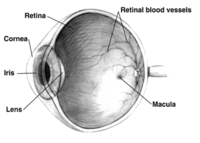
Photo from wikipedia
PURPOSE The purpose of the study was to investigate the changes of choroidal blood perfusion in different layers and quadrants and its possible related factors after 1 h visual task by… Click to show full abstract
PURPOSE The purpose of the study was to investigate the changes of choroidal blood perfusion in different layers and quadrants and its possible related factors after 1 h visual task by augmented reality (AR) device in two-dimensional (2D) and three-dimensional (3D) mode, respectively. METHODS Thirty healthy subjects aged 22-37 years watched the same video source in 2D and 3D mode separately using AR glasses for 1 h with a one-week interval. Swept-source optical coherence tomography angiography (SS-OCTA) was performed before and immediately after watching to acquire choroidal thickness (ChT), three-dimensional choroidal vascularity index (CVI) of large- and middle-sized choroidal vessels and choriocapillaris flow voids (FV%) at macular and peripapillary area. Near point of accommodation (NPA) and accommodative facility (AF) were examined to evaluate the accommodative ability. Pupil diameters by infrared-automated pupillometer under scotopic, mesopic and photopic condition were also obtained. RESULTS Compared with pre-visual task, the subfoveal CVI decreased from 0.406 ± 0.097 to 0.360 ± 0.102 after 2D watching (p < 0.001) and to 0.368 ± 0.102 after 3D watching (p = 0.002). Pupil sizes under different illuminance conditions became smaller after both 2D and 3D watching (all p < 0.001). AF increased after both 2D and 3D watching (both p < 0.05). NPA receded in post-3D watching (p = 0.017) while a not significant tendency was observed in post-2D. CONCLUSION A reduction in subfoveal choroidal blood flow accompanied with pupil constriction was observed immediately after 1 h visual task using AR glasses in 2D and 3D mode. Accommodative facility improved after 2D and 3D watching with AR glasses, whereas decrease in the maximum accommodation power was only found in 3D mode.
Journal Title: Acta ophthalmologica
Year Published: 2023
Link to full text (if available)
Share on Social Media: Sign Up to like & get
recommendations!